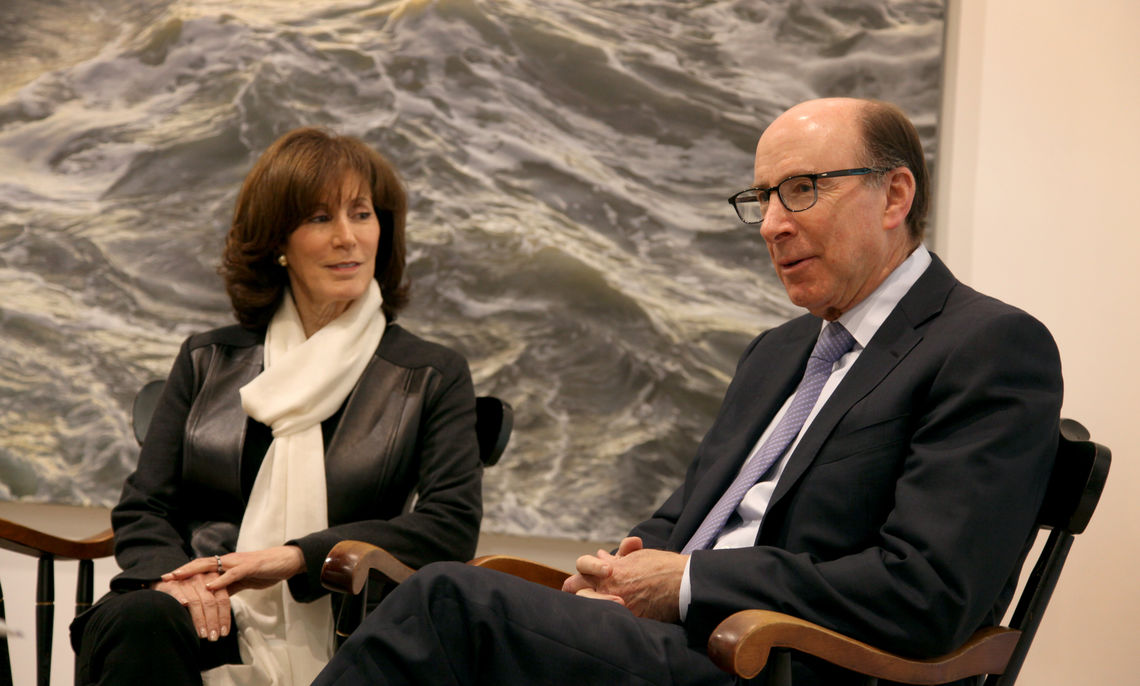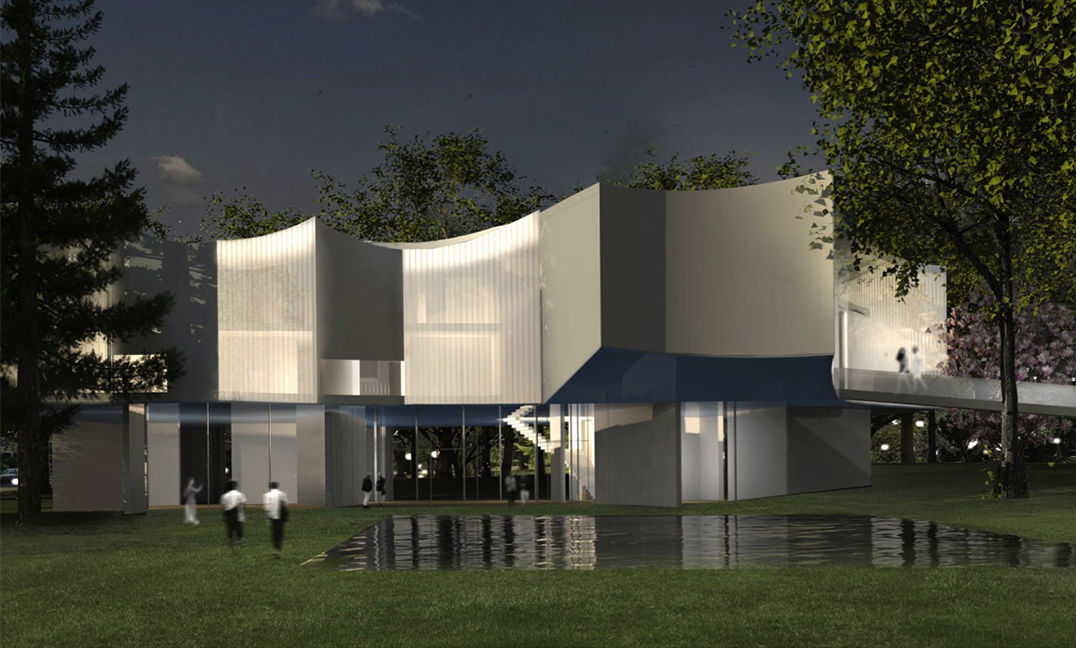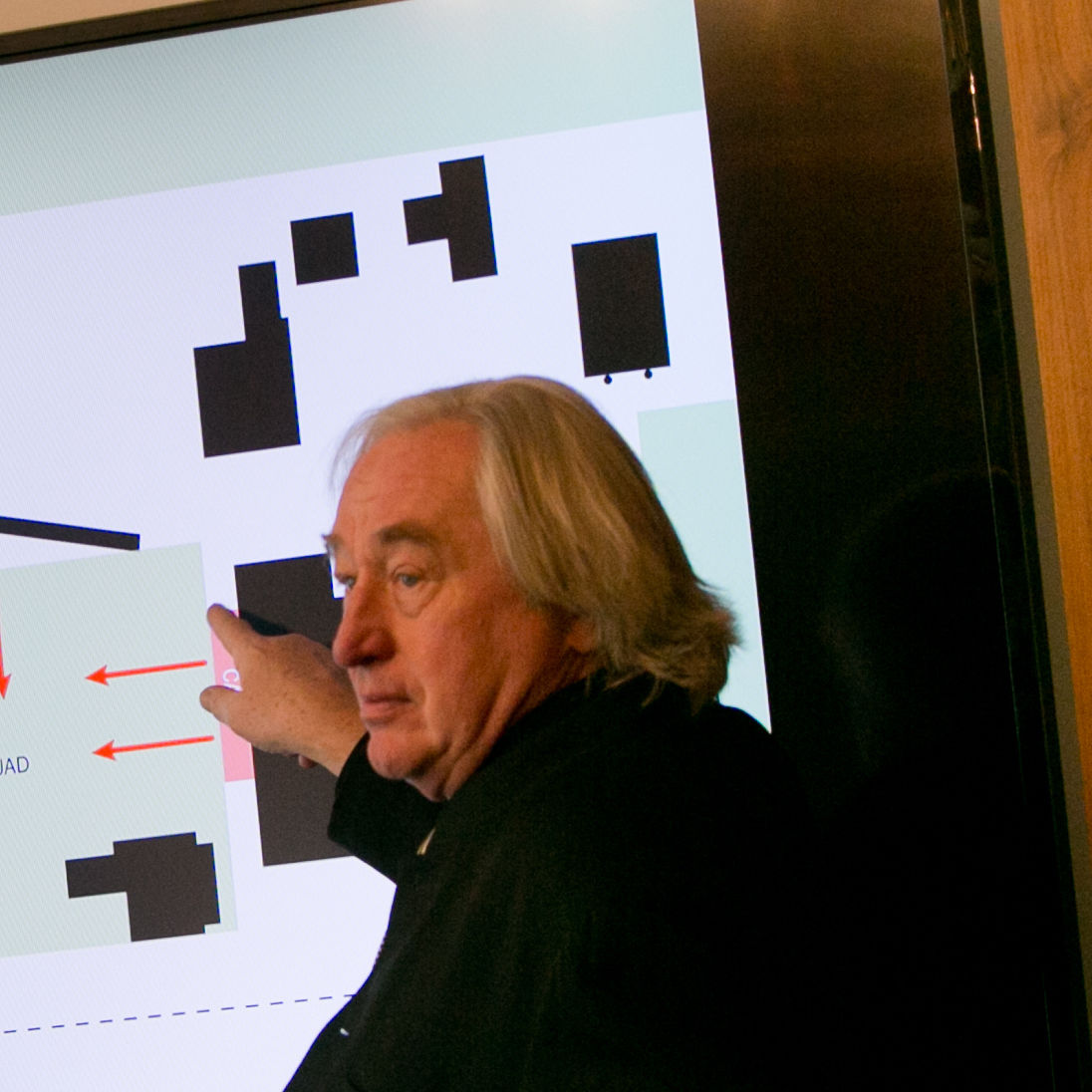F&M Stories
F&M Receives Gift from Winter Family for Landmark Visual Arts Building
Both the study and making of art will gain a new vitality at Franklin & Marshall College, with a lead gift for a new visual arts building announced by President Daniel R. Porterfield during F&M's annual Commencement ceremony on May 7.
A $10 million commitment — the second largest single gift in the College's history — from Franklin & Marshall Trustee Benjamin J. Winter '67 and his wife, Susan, will provide the leadership investment in the project, for which the couple has already helped fund an initial planning phase in 2015.
The College has retained world-renowned Steven Holl Architects, named by TIME magazine as America's Best Architect for "buildings that satisfy the spirit as well as the eye," to design the facility. Holl and Senior Partner Chris McVoy presented their working concept for the project to the College's Board of Trustees during its May 5-7 meeting on campus.
"Great architecture is itself educational," said Porterfield. "It inspires all of us to reach, to imagine, to expand our ideas. It helps us envision the future of liberal arts education for the world we inhabit today."
Ben Winter is principal of The Winter Organization, a leading real estate investment management business focused on the New York metropolitan area, and currently a vice chair the F&M Board of Trustees. He and Susan Winter, a graduate of McGill University in Montreal, are avid art collectors and patrons of many visual and performing arts organizations, including the Metropolitan Museum of Art, the Jewish Museum, and Arts Connection, a nonprofit providing innovative arts programming to millions of students in the New York City public school system.
"No effort of generosity comes without being inspired — by a place, by people, by a project. In this case, it's all of those things," Ben Winter said. "Susan and I continue to be inspired by Franklin & Marshall College, by Dan Porterfield's leadership, and by the young students at F&M who suggest a brighter future and better world ahead for all of us. We're also very excited to be working with one of the world's great architects, Steven Holl, on creating a new campus space that we hope is truly transformative, both for the College and the faculty and students who use it."
"With this visionary gift, Ben and Susan Winter position the College to dramatically enhance our resources for the visual arts while making a bold statement about F&M as a national liberal arts college," Porterfield said. "This new visual arts building will unleash student and faculty creativity. It will amplify the beauty of the quadrangle within which it sits and the adjacent Buchanan Park. It will create an inviting new entrance to the campus and forge a stronger connection to the Lancaster community and its burgeoning arts culture. And it will fulfill our ideals for environmental sustainability, an element of all our new buildings."
At roughly 35,000 square feet, the new visual arts building will be almost double the size of the existing Herman Arts Building, which will be removed to make way for the new structure. The Herman family provided an investment 50 years ago that set the stage for a heightened focus on visual arts at F&M, and its contribution to the College will continue to be recognized.
Holl said the campus' remarkable trees provided a central idea for the composition of the building, which he calls a "pavilion on the park." Raised kite-like into the leafy canopy, the building's light profile is a concave response to the large diameters of the surrounding trees — many of them more than 100 years old and among the oldest things on F&M's historic campus.
A prominent feature of the design is a glass-enclosed forum in the center of the ground floor that will allow pedestrians on the campus side of the building to see through to the green landscape of Buchanan Park. The new building will form part of a new visual arts quad, with a storm water reflecting pool at the south end of campus marking a new entry to the College centered around the arts.
"We don't have a single 'style.' We always try to shape a unique experience, and our approach is the same with this project," said Holl. "We look to create something of this place to inspire future students."
In its preliminary configuration, the four-level building will feature a variety of studios distributed around a central common area on the second floor, along with a specially prepared area for large-scale stone and metal sculpting on the ground floor. Also included will be film labs and a cinema-screening auditorium and lecture hall to support programs in film, photography, and visual studies, areas of study of growing interest.
Classroom space and office/studio spaces for faculty and advanced students will occupy the third floor and overlook both the studios below and the park. The building will exemplify advanced sustainability practices through geothermal heating and cooling integrated with radiant floors.
Next steps in developing the project include further work to refine the design, financial planning around construction and operating costs, engagement with the Lancaster community, logistical planning, and additional fundraising needed to complete the project.
"I've been very fortunate throughout my career to have a liberal arts education from F&M," said Winter, "and I am proud to have served as a trustee of the College for the past 10 years. One thing I've learned during this time is that a national liberal arts college, competing with its peers, must think and operate on a different level than it did even 20 years ago. We're pleased with the thought that the new visual arts building might help the College community see in new ways, think in new ways, and reach together for that next level of greatness."
Faculty in the Art and Art History Department have been involved in planning for the new building since an initial design charrette in February 2015, said Provost and Dean of the Faculty Joel Martin. He anticipates the project will have a transformative impact not only for the department, but also for the College as a whole.
"I am certain that this building, this work of art, will be catalytic, altering our experience of the campus and changing how we and others think of Franklin & Marshall," Martin said. "Visual literacy is increasingly important for all students and visual culture is now a part of every field."
The Art and Art History Department's program in studio art concentrates on the planning and production of visual works that use formal and expressive elements such as composition, shape, form, line, tone, texture and color. Beyond the design and execution of these works, faculty guide students through the processes of applying critical analysis and anticipating the works' ultimate intellectual and emotional communication.
The art history program examines aesthetically considered objects with the goal of comprehending both the objects themselves and the social concerns that they embody, striving to develop students' abilities to appreciate the technical accomplishment, artistic decision-making and expressive effect of various works of art.
More About Steven Holl
American architect and watercolorist Steven Holl first came to international attention in 1988 by winning the Amerika-Gedenkbiliothek International Library Design Competition for an expansion and renovation of the American Memorial Library in Berlin, Germany.
Within a year, his work was exhibited in a solo show at the Museum of Modern Art in New York City. The prestigious institution would subsequently purchase 25 of his works for the museum's permanent collection.
Buildings designed by Holl can be found around the world, from the "Linked Hybrid" building complex in Beijing, China, and Kiasma Contemporary Art Museum in Helsinki, Finland, to an expansion of the Kennedy Center for the Performing Arts in Washington D.C., and the new Rubenstein Commons project for the Institute for Advanced Study at Princeton University.
Other college and university campuses in the United States and abroad feature some of Holl's designs. He created the Chapel of St. Ignatius at Seattle University in Washington State, the University of Iowa School of Art and Art History, the Campbell Sports Center at Columbia University, the Seona Reid Building at the Glasgow (Scotland) School of Art, and the PhD Building for the National University of Colombia in Bogotá.
In 2011, Holl was named a Senior Fellow of the Design Futures Council, and in 2012 received the American Institute of Architects Gold Medal in recognition of his "significant body of work of lasting influence on the theory and practice of architecture."
A graduate of the University of Washington, Holl pursued architecture studies in Rome before attending graduate school at the Architectural Association School of Architecture in London. Together with Senior Partner Chris McVoy, he leads Steven Holl Architects, based in New York City, where Holl has taught at Columbia University since 1981.
Related Articles
January 2, 2026
The Year in Photos
A calendar year on campus is full of both subtle and significant moments that help define us as Diplomats. Deb Grove, Franklin & Marshall staff photographer, selected an image for each month of the year.
December 29, 2025
Top Videos of 2025
Enjoy a compilation of videos that capture campus memories from the past calendar year – from the first steps students take on campus to the moment they triumphantly toss their mortarboards in the air.
December 23, 2025
F&M Welcomes First Members of Class of 2030
Nearly 200 remarkable students from around the world are admitted to F&M after applying Early Decision; Next application deadline is Jan. 15



